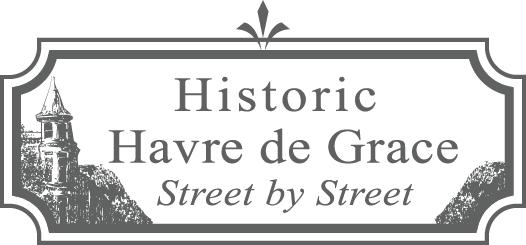Address Page
Back to All Listings
212 South Union Avenue, Sappington House, c. 1838
Stop #28 on The Lafayette Trail
William Platt C. Whitaker (1813-1888) and his wife, Mary, originally owned this land and nearby lots and in 1833 sold five lots to Thomas Sadler (1797-1889). Thomas and Mary Sadler sold the lots five years later to Dr. John Kentucky Sappington (1791-1868), a prominent physician, who it is believed built this house in 1838. “Dr. Sappington” appears in this location on the Herrick and Jennings 1858 Map of Harford County. His wife, Rebecca Neeper, had died young in 1833. He then married Abiann Steele Sappington (1797-1850) with whom he had a daughter, Abigail Helen Sappington (1838-1901). Abigail married Israel Matthews of Elkton in 1864 at the nearby Blenheim Estate.
This is referred to as one of the “Canal Houses” because of their origin dating back to 1840 when the Susquehanna & Tidewater Canal opened and expectations were high for the future material prosperity of the city. This is one of the three brick Greek revival houses built in this block around the same time—including The Hoke House (213 South Union Avenue) and The Hall House (227 South Union Avenue). The front facade has a one-story, two-bay Doric portico with a balustrade and slightly hipped roof. An intricate frieze on the fascia can be seen above the porch. A distinguishing feature of the Sappington House is its fully raised lighted basement, lined in brick, with a large cooking fireplace, and windows. These basements were originally built for servants.
Dr. John K. Sappington’s parents were Richard K. and Cassandra D. Sappington and Dr. John had a younger brother, Dr. William Sappington, who purchased the Blenheim Estate in 1831. Dr. John Sappington was a veteran of the War of 1812 and was a prominent physician in Maryland. When in 1866 the Medical Society of Harford County was established, Dr. John Sappington was elected as its first President. After his death two years later, this home was put up for sale by his executors. George Taylor Lyon (1816-1891) bought the house in 1875 as well as the entire block of Union Avenue between Fountain and Bourbon Streets.
Just a few years later, this home was the location of what the Wilmington News
described as “the biggest social event of the season,” and “in the home on Union Avenue of ex-Councilman George T. Lyon” on March 31, 1881. The party began in the “mansion” and then “adjourned to City Hall.” All the prominent social and business people of the city were invited on a specially printed invitation.
After George T. Lyon’s death his widow, Maria Lyon, sold the property in 1901 to John N. Spencer. He, however, died in 1916 and the following year this house was sold to W. Scott Silver (1871-1942), who was in the canning business. Scott Silver and his wife, Florence S. Silver (1874-1964) had previously lived at 860 Ontario Street. Although Scott Silver died in 1942, Florence continued to live in this home until 1957 when she sold it to Murray and May Lawder.
The home had been modified as apartments by 1976, but it is not known exactly when this happened or who converted it. Paul Bailes rented an apartment on the second floor at some point and says he is convinced it was haunted. After a couple more owners, the home was bought by Alice and Michael P. Boyd, Sr. in 1985 from William D. Smith. Michael Boyd ran “Mike’s Home Supply Center” for some time and also had a contracting business. Although Alice Boyd died in 2017, Michael continues to own the building and he lives in one of the apartments.
This Sappington House is the twin of the Hoke House across the street—at least as originally built. It has endured several additions and alterations, not the least of which is an exterior coat of ox-blood red paint. This property received an award from the Havre de Grace Historic Preservation Commission in 2014.
County Records
Built 1838. 4570 sq ft, 3 stories with basement. 4/2 baths, 12,000 sq ft lot, detached garage.
Built 1838. 4570 sq ft, 3 stories with basement. 4/2 baths, 12,000 sq ft lot, detached garage.
Follow Us
Copyright © 2020 - 2025 George Wagner
